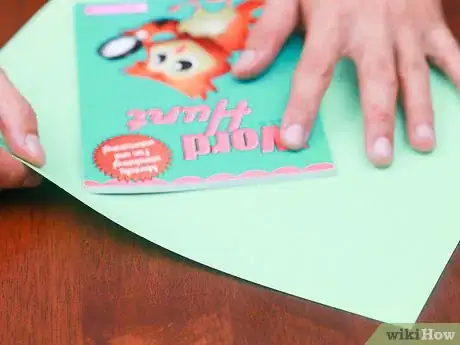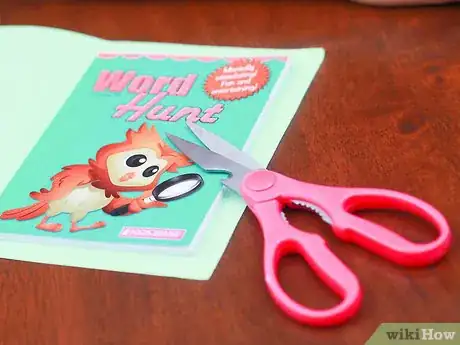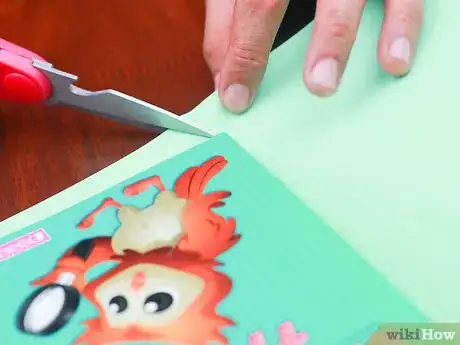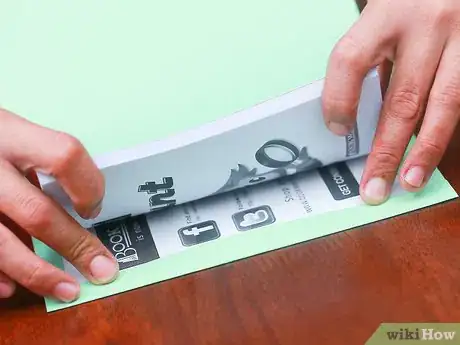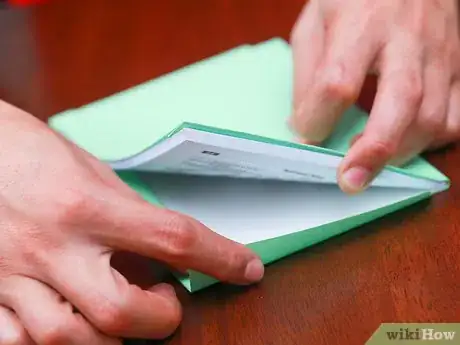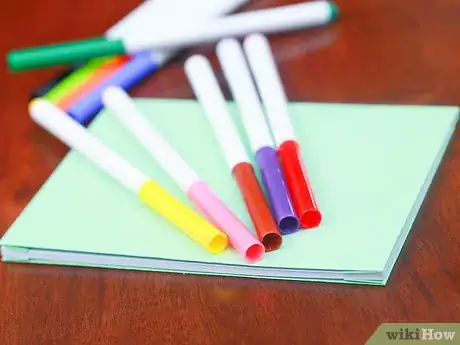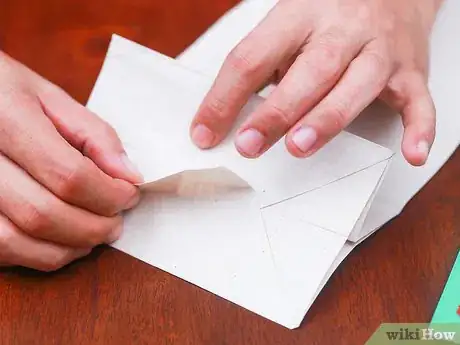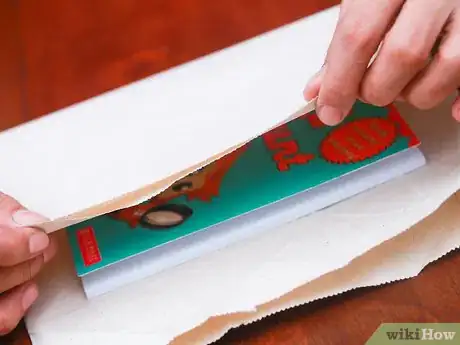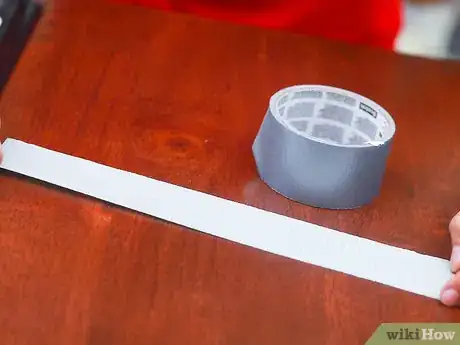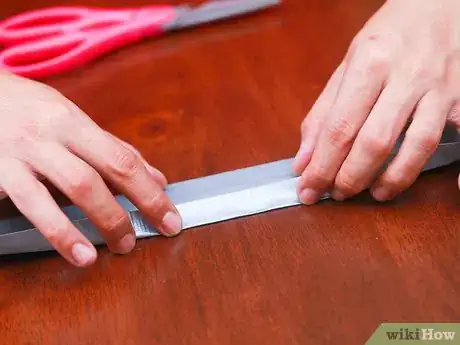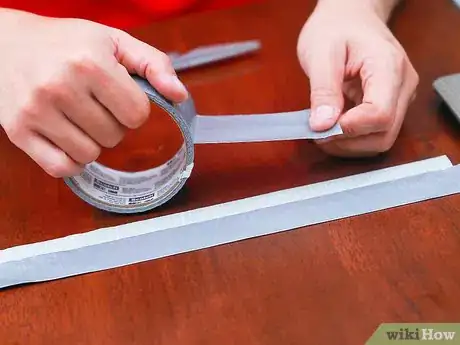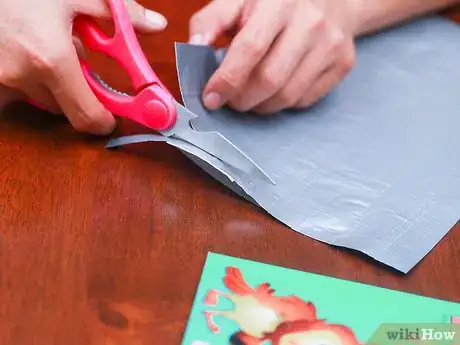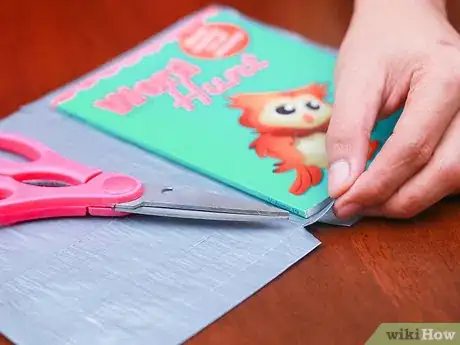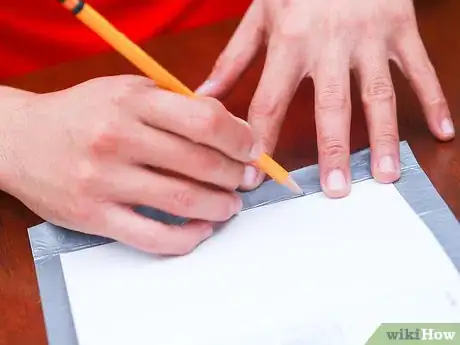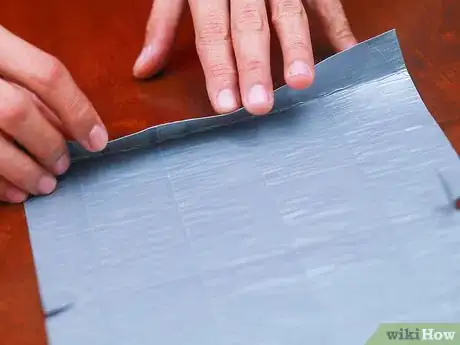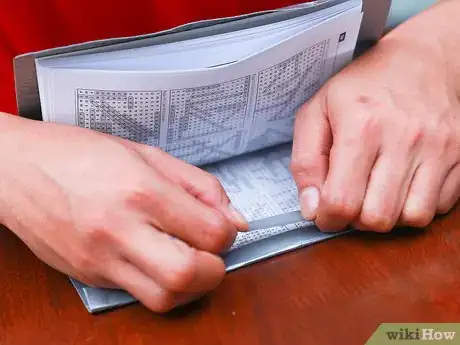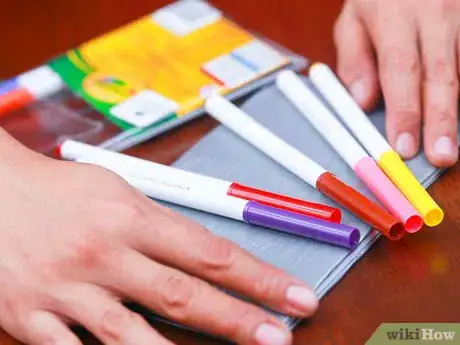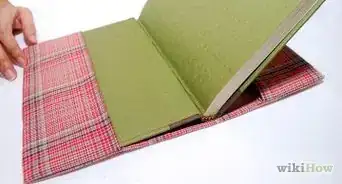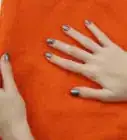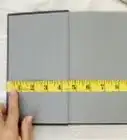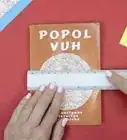X
wikiHow is a “wiki,” similar to Wikipedia, which means that many of our articles are co-written by multiple authors. To create this article, 30 people, some anonymous, worked to edit and improve it over time.
This article has been viewed 162,508 times.
Learn more...
School textbooks can be very expensive — in fact, at some colleges, students can end up spending over $1,200 per year on books alone.[1] Why risk damaging or ruining these expensive investments when you can make a quick and easy cover using paper sheets, paper bags, or duct tape? The pennies you spend on a simple paper cover can save you handfuls of cash in the long run, so don't wait — cover your books today for lasting protection.
Steps
Method 1
Method 1 of 3:
Using a Sheet of Paper
-
1Get enough paper to cover your book in a single sheet. With this method, we'll use a sheet of paper to give our textbook a quick, easy, and affordable cover. To start, lay your paper on a flat surface, then open the book and lay it cover-down on the paper. The paper should extend beyond the book's edges. If it doesn't, your paper isn't big enough.
- There are a wide variety of papers that are suitable for your cover. In general, thicker papers (such as construction paper) will provide the most protection, though decorative papers (such as wrapping paper) can be more visually appealing. (Later in the article there will be a discussion on how to decorate and strengthen paper covers.)
- You can also use materials that are paper-like, such as wallpaper, Tyvek (often used for packaging), and duct tape (see below in the article).
-
2Trim the paper so that it's slightly bigger than the book. Using a ruler, cut the paper so that it extends one to two inches or so to past long edges and about two to three inches past the short edges. This gives the cover enough material to stay seated around the book, but not so much that it will be awkward to work with.[2]Advertisement
-
3Cut wedge-shaped slits next to the spine. The "spine" is the hard part of the book in the middle of the cover where all the pages meet. Make two wedge- or triangle-shaped cuts in the middle of the long edges of your paper sheet that stretch to the edge of the book. These cuts should line up with both ends of the book's spine.
- If you don't do this, you will run into problems in the next step when you fold the extra paper material over the edges of the cover. It is physically impossible to fold the paper over the pages themselves, so your paper cover will scrunch and eventually tear as you open and close the book.
-
4Fold in the edges. Pick either the front or back cover of your book to start making your cover. First, fold the longer edges of your paper over the book's cover so that they sit against it reasonably tight. Then, fold the four corners of the paper in so that they're aligned with the edges of the folds you just made. Finally, fold the shorter edge of your paper in to complete the cover.
- Use pieces of tape to hold your work together as you go and to secure the cover once you are done folding.
-
5Close the book and repeat for the other cover. When you have finished taping one side of your new cover, close the book to hold it in place, open the opposite cover, and repeat the folding procedure exactly as above. Tape each fold as you go.
- Congratulations! Your book cover is now complete. Anything you do to your cover after this point is completely optional.
- One thing you may want to experiment with is laying a strip of tape along the spine while the book is closed. Generally, the spine is the part of the cover that receives the most wear, so protecting this with tape can prevent it from wearing out prematurely.
- Taping the corners likewise helps eliminate a common wear point. It also has the advantage of making the cover stay on more securely to the book.
- Sturdy tapes like packing tape or duct tape are best, though layered scotch or masking tape can work surprisingly well.
- Congratulations! Your book cover is now complete. Anything you do to your cover after this point is completely optional.
-
6Decorate your cover! Before taking your textbook to class, you may want to spruce up your plain, old boring cover. How you do this is up to you — as long as whatever you choose doesn't mark or damage your book, it's probably fair game. Below are just a few ideas — feel free to go wild with your own.
- Drawings and doodles (take care not to use pens or markers that bleed through your cover)
- Stickers
- Duct tape designs
- Negative-space designs (i.e., cutting some of the cover out in a decorative shape)
- Cut-outs from magazines, advertisements, etc. Just cut and paste.
-
7Label Your Textbook. Label your textbook on both the front and on the spine. Make each book cover distinctive in some way, such as different colors, decorations, or however works for you. When you are in a hurry, it is easy to confuse one textbook with another in your locker, backpack, or at home.
- Include a way of reaching you if the book is lost, such as your school, a phone number or e-mail. If you leave your textbook somewhere, it is more likely to get to you or the school if the do-gooder who finds it can know how to get it to you.
- Just be sure not to include any sensitive identifying information like an address or a student ID number.
Advertisement
Method 2
Method 2 of 3:
Using a Paper Bag
-
1Obtain Kraft paper. The go-to material is the thick, brown paper called Kraft paper. This is what paper bags like the kind you might get at the supermarket is made from. Kraft paper is available on rolls anywhere shipping supplies are sold, and it is a little easier to work with. However, obviously that paper is not free.
- Make sure your bag is large enough to cover both sides of your book before beginning.
-
2Cut the bag into a single sheet. Start by cutting out the bottom of the bag along its folds and removing any handles if your bag has them. Make a single vertical cut along one of the bag's corners. Your bag should now look like a single, rectangular sheet of paper.
-
3Fold your cover as you would for a normal sheet of paper. Now that you have more or less turned your paper bag into a single sheet of paper, the rest of the process is easy. Just follow the steps in the section above, using your cut-up paper bag in place of the sheet of paper specified.
- Ignore the folds that may remain in the sheet of paper you have cut from your paper bag — make your own folds.
- Ironing the paper on medium heat on an iron can get rid of any fold marks that may confuse you, or just make a really nice, tidy piece of paper.
Advertisement
Method 3
Method 3 of 3:
Using Duct Tape
Making a Duct Tape "Sheet"
-
1Lay down a single strip of tape sticky side up. In terms of long-term durability, it's hard to beat a textbook cover made entirely from duct tape.
- However, since sticking duct tape directly to the textbook can be quite damaging in its own right, before starting, you'll need to make a "sheet" of duct tape material that's non-sticky on both sides. This isn't as hard as it sounds, though it can be somewhat time-consuming. To begin, pull a single long strip of tape and lay it on your work area face-up.[3]
- Your strip of tape should be about three to six inches longer than your book is in height. In the rest of this section, you will want to use tape strips that are roughly the same length as your first, but keep in mind they don't need to be exactly the same.
-
2Lay a strip of tape on the top sticky side down. Take a second strip of tape and very carefully lay it sticky side down on top of the first so that it covers about half of the first piece. Press it down so that there are no wrinkles.
-
3Fold the first strip of tape over. Take your first piece of tape (the one that is sticky side up) and fold it over the top of the second, pressing it down to get a clean and even fold. This now forms one "edge" of your sheet — you will continue to lay down more tape in the opposite direction.
-
4Flip over and repeat. Lay down a third strip of tape on the tape that's now sticky side up. Be sure not to leave any gaps where sticky adhesive can be seen — if these get pressed against your book cover, they can cause it to tear.
- You may even want to overlap your tape slightly to make sure that no stickiness shows through.
-
5Continue this pattern until you have a "sheet" larger than your book. Keep flipping your tape and laying down new strips. Before long, you should have a "sheet" that's sticky side down on both sides. Once this sheet is big enough to leave a few inches on every side of your book, make your second edge by folding the final piece of tape back over itself to conceal the sticky part.
-
6Trim your "sheet" into an even rectangle. Open your book and lay it cover side down on your sheet. Use a ruler to mark straight lines along the edges of your sheet that cut off all the mismatched tape ends. Use a pair of scissors, a razor blade, or an X-ACTO knife to cut along these lines.
- When you're done, you should have a sheet that's perfectly rectangular (and still extends beyond the edges of your book by a few inches on each side).
Advertisement
Putting Your Cover on Your Book
-
1Cut wedge-shaped holes for the book's spine. Compared to making your duct tape sheet, the rest of your work is easy. Start by opening your book and laying it cover side down on your duct tape sheet. Use diagonal cuts to cut out a small wedge-shaped piece above and below the book's spine. When you're done, there should be small gaps at the top and bottom of the sheet that line up with the book's spine.
- This is done for the same reason as in the paper method above — without this, opening the book puts stress on the portion of the cover next to the spine, causing it to fold awkwardly and eventually wear.
-
2Mark the folding lines for your duct tape cover. Fold the short edges over the book's covers and mark the lines where the sheet folds. Repeat this folding-and-marking process for the long edges.
-
3Press these creases. Remove the book from the sheet. Refold your sheet along the lines you just drew. Press the folds down to make strong creases. Lay a heavy object (such as your textbook) on top of each crease for a few minutes to flatten the folds.
-
4Tape the cover around your book. Once you have got nice, flat creases, put your book back onto your sheet and fold the cover around it, folding the long edges of the sheet around the cover first and then folding the short edges over with diagonal folds. Use skinny strips of duct tape to secure each fold.
-
5Optionally, decorate your cover. Congratulations — your cover is done and you can decorate it however you like. While pens and markers won't show up well on dark-colored duct tape, you can still try making designs with different colors of tape, adding adhesive decorations (like rhinestones), and so on.
- As advised above, label your textbooks and make it easy for a lost book to find you.
- You may also want to try laying strips of white masking tape down on the front cover and spine to use as labels. This is a good idea for keeping track of the subject of each book.
Advertisement
Community Q&A
-
QuestionCould I use washi tape?
 Kitty65152Community AnswerYes, but make sure to use measurements. If you want, you could also put clear tape over the washi tape to secure it.
Kitty65152Community AnswerYes, but make sure to use measurements. If you want, you could also put clear tape over the washi tape to secure it. -
QuestionHow do you make a book cover out of wrapping paper?
 Community AnswerThe paper bag method listed in the article will work with wrapping paper.
Community AnswerThe paper bag method listed in the article will work with wrapping paper.
Advertisement
Warnings
- Using more than one sheet of material for your cover is ill-advised — these sorts of covers can wear along the seam (even if it's taped-over and may eventually fall apart.⧼thumbs_response⧽
Advertisement
Things You'll Need
- Textbook to cover
- Paper or fabric to cover it with (see tips)
- Tape
- Duct or packing tape
- Markers and other decorating stuff(optional)
References
About This Article
Advertisement
